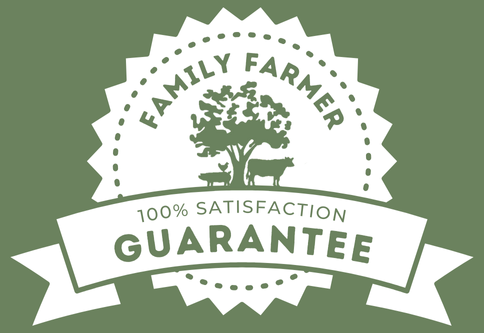Industrial Ag's Paradigm: Cheap Food, Unsustainable System
posted on
March 3, 2024
Let’s continue our conversation on my series of “Regenerative Farming”. The last blog post I shared was all about the Industrial Farming Revolution. We covered the industrial change of agriculture and how the farming model transformed to be more efficient and productive in food production than ever seen in history. Feel free to read that article here if you want a full refresher or in case you missed it.
Today’s blog is to cover the industrial Ag’s paradigm: cheap food, but an unsustainable system.
I don’t argue with the Big Ag gurus. We’ve increased our production and efficiency in modern agriculture significantly and produce less expensive food.
In fact, 100 years ago, 43% of the average American's income went towards their food bills. Today, that expense is 13% (half being eating out).
And don’t take this article wrong, I stem from an entrepreneur mindset and want to see the new advances in technology to improve our lives.
However, as a farmer entrenched in agriculture, I've witnessed firsthand the consequences of this farming model. While this model promises increased productivity and efficiency, the toll it takes on the environment, society, and human health cannot be overlooked. From degraded landscapes to struggling rural communities and health crises, industrial agriculture takes a heavy price that we don’t see at the grocery checkout counter.
Negative Environmental Impacts
Industrial agriculture's environmental footprint is undeniable. The widespread use of chemical fertilizers and pesticides are polluting our soil, water, and air. First, the runoff from fields laden with agrochemicals contaminates waterways, leading to dead zones and harmful algal blooms.
The common monoculture cropping practices deplete soil fertility, erode biodiversity, and degrade natural habitats. All this with down stream affects…as today we lose pollinators and beneficial insects. That loss further disrupts delicate ecosystems, threatening the stability of our environment.
Probably my biggest pet peeve that I see in modern agriculture is the eroding topsoil.
Top soil is the black organic layer that sits on earth’s surface. It’s responsible for feeding the plants that grow and the layer that is full of microscopic life! The higher the amount of topsoil in a soil sample’s profile, means the healthier the land is.
One of the unsustainable practices in modern agriculture is continued tillage: As soil is tilled to eliminate weeds (unwanted plants), it becomes acceptable to erosion and threatens the microscopic life.
Unfortunately, we are seeing our precious topsoils leaving farms at alarming rates from wind erosion (think of the great dust storms in our history) and water erosion (heavy rains wash the soil into our waterways).
The microscopic life that lives on the plant roots in our top soil plays a vital role in storing carbon. As the tillage destroys these plant roots, it also destroys the microscopic life community as well and releases carbon dioxide back into our atmosphere. All this adds to our carbon footprint.
Our number 1 rule as a regenerative farmer is to keep the soil covered!
The second common practice is all the chemicals. These also are a detriment to our soil microscopic life, killing not just the weeds, or pests, but negatively affecting all life in their path.
The last issue I'd like to mention is mono-culturing. This is exactly what nature abhors. Nature prefers diversity. Show me where in nature, it grows one plant on hundreds of acres all by itself. It doesn’t. All plants work symbiotically.
I can go on with more detail on this topic, but we will save that for another blog post!
Social and Economic Downfalls
While industrial agriculture may boost yields in the short term, its long-term social and economic consequences are dire. Unfortunately, the large-scale monoculture operations have displaced small family farms, eroding the fabric of rural communities.
I see family farmers struggle to compete with industrial giants, leading to the loss of their livelihoods and cultural heritage. It’s really sad to see, quite honestly.
Moreover, the consolidation of agricultural power in the hands of a few agribusiness corporations exacerbates income inequality and economic disparities. The reliance on genetically modified seeds and proprietary inputs further entrenches farmers in a cycle of dependency, eroding their autonomy and resilience.
Not to get too carried away into this subject, but I feel the farmers today have become slaves to the big multinational corporate giants. Somehow, these companies have gained incredible amounts of power and money that help fund the agriculture education system, the government policy, and great marketing strategies to strip away profit margins from these hard working family farms. It saddens me to see how many farms have been duped by this corrupt system.
Health and Wellness Problems
The health implications of industrial agriculture extend far beyond the fields. As they point out the decrease in food costs from the industrial model ....What they don’t share is how much our health costs have increased over the years. The average American's health cost as a percent of GDP increased from 5% to 18% from 1960 to 2016.
The indiscriminate use of pesticides and herbicides has led to acute poisoning and chronic health issues. The careless use of these chemicals in our food production sickens me.
Another fear I have is the overuse of antibiotics in livestock farming contributing to the rise of antibiotic-resistant bacteria, posing a grave threat to human health. This is a great technology, which I do think has a place, but it’s been abused both in livestock and human medicine.
I will give the agriculture industry credit. I’ve read many articles in publications talking about this issue. So maybe they want this to change? It seems like there’s a start to push against this common practice. Tough to say.
My final point is we’ve seen a decline in the nutritional quality of industrially produced food due to soil degradation and genetic manipulation impacting human health and well-being. As diet-related illnesses such as obesity, diabetes, and heart disease continue to rise, it's evident that industrial agriculture is failing to nourish our bodies and communities.
All this said. Americans currently have the lowest cost of food, but the highest cost of healthcare in the entire world. While I’m sure there’s other factors to consider in that fact, it sure seems to line up exactly with my point.
Sustainable Solutions
If you made it this far into reading this. Thank you.
As a farmer committed to stewarding God’s land and nourishing my community, I believe it's time for America to reimagine our agricultural systems.
Transitioning away from industrial agriculture towards regenerative practices offers a path forward. By prioritizing soil health, biodiversity, and community resilience, we can cultivate a more sustainable food system.
Approaches such as crop rotation, cover cropping, and integrated pest management promote natural processes while reducing reliance on synthetic inputs and the big corporate giants.
Now that I proved my point, that we can’t continue on with industrial agriculture. The biggest objection many ask is: “Can we scale regenerative agriculture?”
This question is valid. However we will have to tackle this question in my next blog article!
God bless,
Farmer Joe



